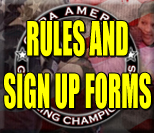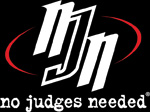Copa America Submission Sport MMA Rules:
|
SPORT MMA DESCRIPTION: Think of it as the equivalent of light contact version of MMA. A division were competitors can compete against each other utilizing most of the regular techniques associated with MMA including strikes, shoots, grappling and submissions. Only semi or light contact is allowed at all times at both stand up and ground positions. The main unique rule imposed is that of “best of three tap out�?. This rule was introduced to allow competitors to gain as much experience as possible’ especially at large tournaments where there is not enough time to include a “loser’s pool�? or round robin system. Basically two competitors start from stand up position as is the case in semi & light contact, utilize their striking (stand up skills) to close the gap and create opportunity for a shoot or take down. Once on the ground the grappling comes into play together with semi/light contact striking. There are strict rules pertaining to Legal and illegal techniques in strikes, grappling/Jiu-jitsu and submissions. The ultimate will always be to obtain a submission over your opponent. EXPLAINING THE BEST OF THREE SUBMISSION RULE If fighter A obtains a submission over fighter B, it is recorded on the score sheet and the fight gets restarted from center stand up position. Fighter B must now obtain a submission over fighter A in order to level the field. Herein begins the chess game of SPORT MMA. Regardless of how good the rest of the fight is from fighter B, even if he is the superior technical competitor, gains more points for striking or outclasses fighter A for the duration of the bout, fighter A will win the match should fighter B not obtain a submission over fighter A. Two submissions over any fighter ends the bout immediately! The final outcome of the fight is decided by (1) if there is a leader by submission (2) if there is no leader by submission the bout is decided by way of points in one of the following options;
The objective of the competition obviously becomes the balance between defending your position to minimize submission, and the timing of your offence in order to create opportunities to submit your opponent. The game changes as the bout continues. If you are submitted, it becomes critical to re gain neutral position by submitting your opponent thereby being able to continue your plan of attack. Likewise if you gain submission first, you can concentrate more on defense, technique and ring craft to keep your opponent at bay utilizing your stand up striking skills but without “spoiling the fight�?. This way students have to become skilled at all levels and cannot rely only on one particular strength to win each bout. Just like the real thing but without the concussion and un-wanted facial alterations. As a fight, it has all the requirements of a MMA bout but without the risk of serious injury. It does not guarantee no injury! It still remains very tough, challenging and extremely physical. Clashes will still occur by accident and blood might still be drawn without malicious intent. But by far, it becomes a division all sport orientated competitors would want to enter. There is a demand for these divisions and as advocates for non full contact with juniors we feel that these divisions give everyone the opportunity to experience the thrill of MMA knowing it’s going to still be tough, that you still have to prepare as if going into a full contact fight but with the knowledge that your organization, instructors and officials have your safety and best interest at heart. More importantly, can you imagine the skill and experience obtained throughout your youth competing in these divisions in preparation for one day competing in MMA.
BASIC RULES
SAFETY EQUIPMENT ALLOWED:
ALLOWED TECHNIQUES:
STRIKES - HANDS:
STRIKES – LEGS & FEET:
SHOOT & TAKE DOWNS:
GRAPPLING – SUBMISSIONS & LOCKS:
LENGTH OF MATCH: KIDS AND TEENS: Two 2 X 1.5 minute Rounds ADULT MEN AND WOMEN : Two 2 x 2 minutes Rounds POINT VALUES AND WINNER DETERMINATION: as described above MAJORITY VOTE: Points are awarded by a majority vote of all judges. The majority of judges do not have to agree collectively who the winners are. Majority of the judge’s decision will ensure the win. During the match, if there is stalling on the ground, the referee has the right to restart the match standing. If the competitors go off the mat, the match can be stopped by the referee, and the competitors will be moved to the middle of the ring/mat in the same position, if that position can be determined by the referee. The referee has the right to stop time and check the condition of the fighters. LEGAL TARGET AREAS: Head and face, ribs, chest, abdomen & legs. ILLEGAL TARGET AREAS: Spine, back of neck/Head, throat, sides of the neck, Kidneys, groin, knees and back. NON-TARGET AREAS: Hips, shoulders, buttocks, arms, and feet. LEGAL TECHNIQUES: As described above. Legal techniques are all controlled sport karate/kickboxing techniques, except those listed as illegal. ILLEGAL TECHNIQUES: Head butts, hair pulls, bites, scratches, elbows, knees (Juniors), eye attacks of any kind, take downs on a hard surface floor, any stomps or kicks to the head of a downed competitor, slapping, uncontrolled blind techniques, any uncontrolled throws, takedowns or sweeps with the intention of slamming the opponent to the ground or landing with excessive force on top of opponent and any other uncontrolled dangerous techniques that are deemed unsafe in sport Martial Arts. GRABBING: Is allowed but no pulling on any part of the pants or top worn by any competitor. SWEEPS, TAKEDOWNS, GRABS AND GROUND FIGHTING: Sweeps to take down an opponent, to obstruct the balance so as to follow up with a technique is allowed. A sweep must be deemed a proper sweep and not a kick, to be legal. Controlled sweeps that are meant to take down an opponent are allowed only on a declared approved padded surface. LIGHT TOUCH CONTACT: Means there is no penetration or visible movement of the competitor as a result of the contact. Light touch is required to all legal target areas in all sparring WARNINGS AND PENALTIES: One and only one warning is allowed for breaking the rules before a MINUS POINT is recorded on the draw sheet or score card. After the first warning is given, a Minus point is awarded for each and every rule violation. If a competitor receives 3 warnings (three penalty points) in any one match, he/she will be disqualified. If the severity of the first rules violation is deemed by the referee to be too severe, a minus point can be issued immediately or immediate disqualification can be enforced. If, in the opinion of the referee and/or the medical personnel, a competitor cannot continue because of an injury caused by an illegal penalized attack executed by his/her competitor, the offending competitor shall be automatically disqualified. Other Cause for Penalization: Attacking illegal and non-target areas, using illegal techniques, running out of the ring to avoid fighting, Preventing your opponent from initiating combat, continuing after being ordered to stop, excessive stalling, blind, negligent or reckless attacks, uncontrolled techniques, showing unsportsmanlike behavior by the competitor, his/her coaches, friends, etc., excessive contact, and delay of time are examples of possible penalization. DISQUALIFICATION: Requires a majority vote by all officials, unless it is an automatic disqualification. Non-Competing Penalty: If, in the majority opinion of the officials, it is considered that the competitors are not making an obvious attempt to fight in the true spirit of competition, both competitors will be warned and if it continues, will be disqualified. Wrong Division: If any competitor competes in a division he/she does not qualify to compete in due to age, weight, rank, gender, style, etc., he/she will be disqualified. COACHING: The luxury of having a coach is something that most competitors do not have access to. Therefore, it sometimes can become an unfair advantage over a competitor who does not have a coach. The rules are made and enforced so no one competitor has an advantage or disadvantage over another competitor. Therefore, coaching is allowed but only under the following guidelines: Never, at any time, can a coach enter the ring without the referee’s permission, 2. No abusive, violent, unsportsmanlike or overzealous coaching; 3. Coaches cannot ask for a time out (only the competitor may ask for a time out), 4. Coaches can never, at any time, interfere with the proper running of the ring or the decisions of the judges. A Coach is defined as anyone who is trying to help one competitor in anyway. A coach could be but is not limited to a friend, parent, team mate or official coach. The centre referee can issue a warning to a competitor for each time his/her coach is interfering with a match or disrupting fair play between contestants. |
|
|









